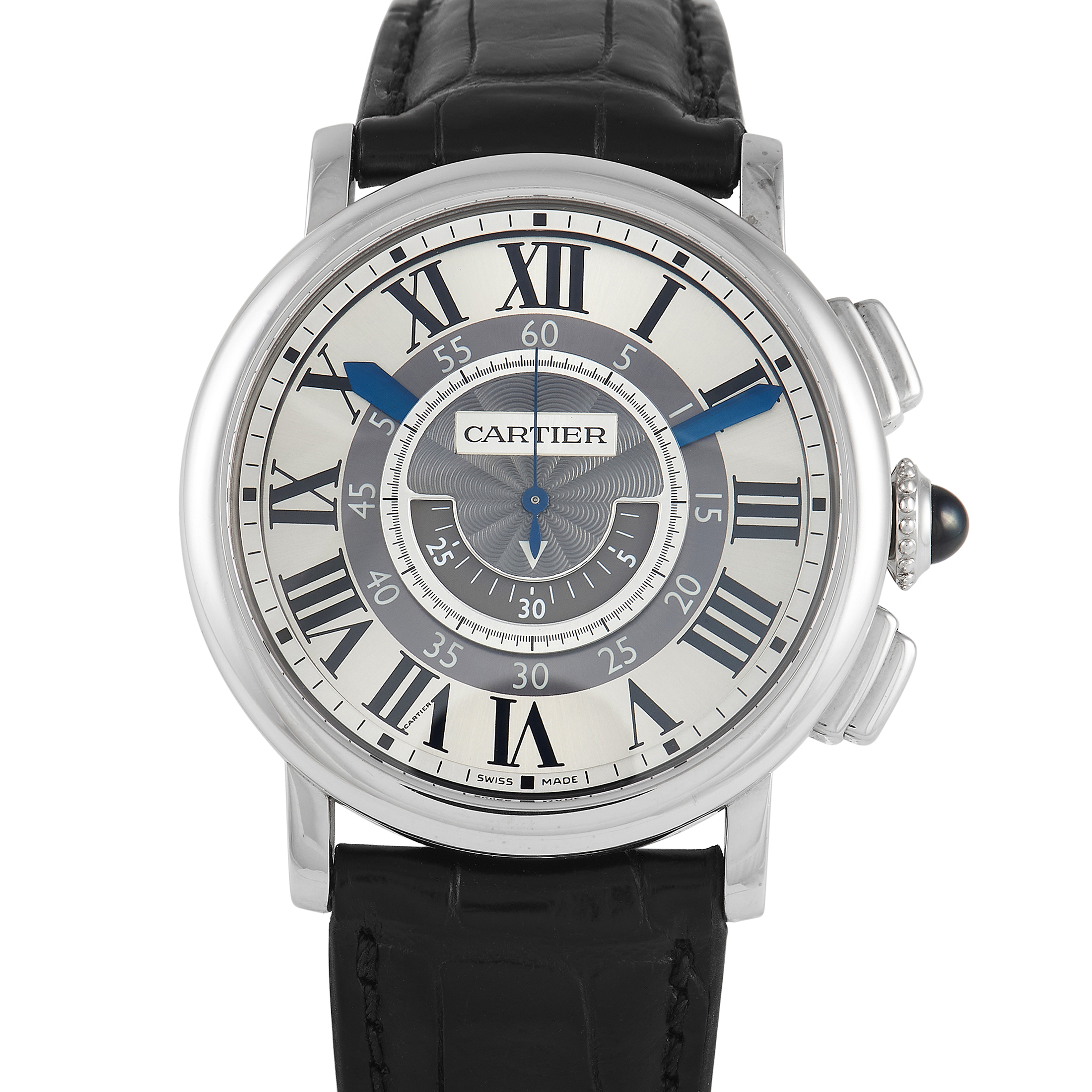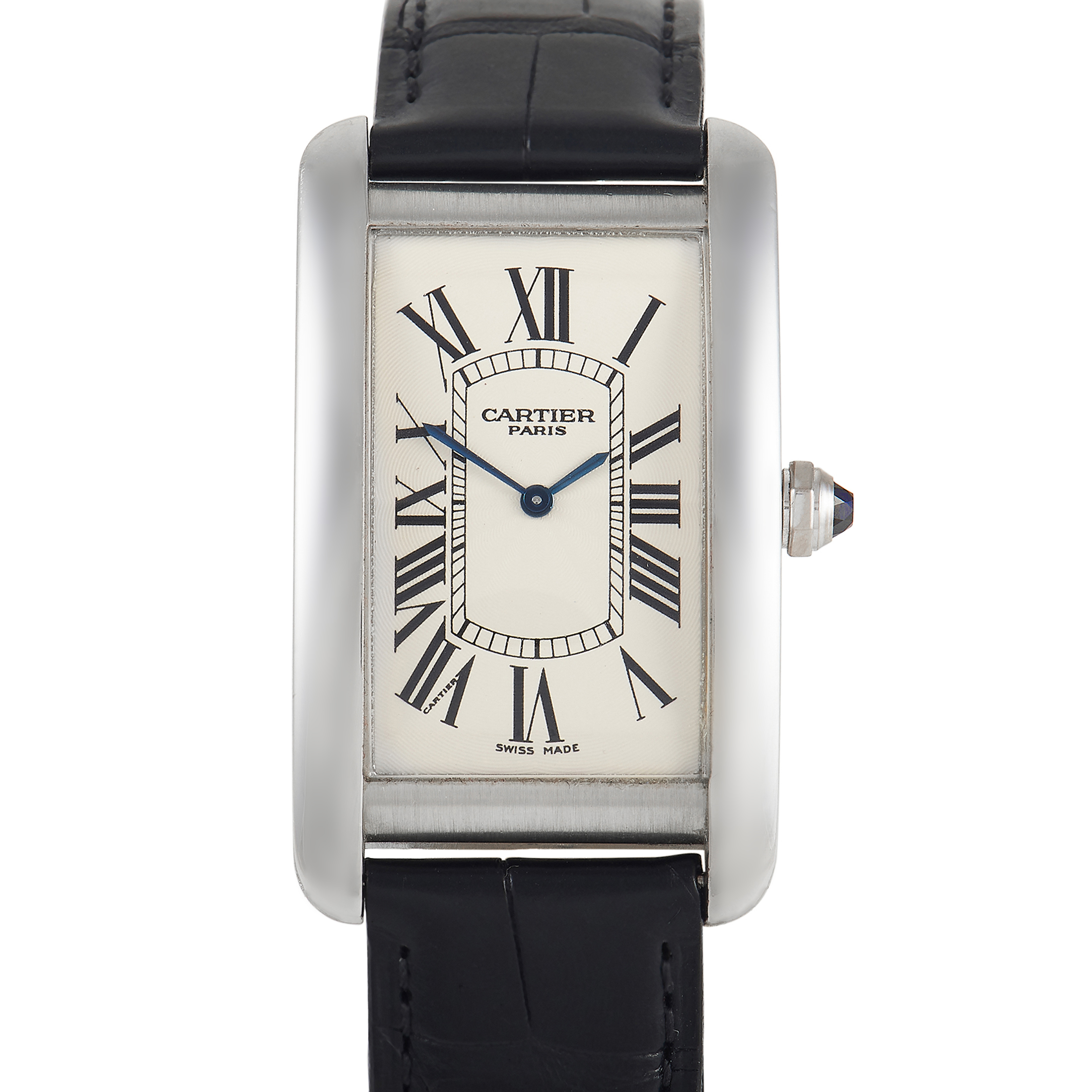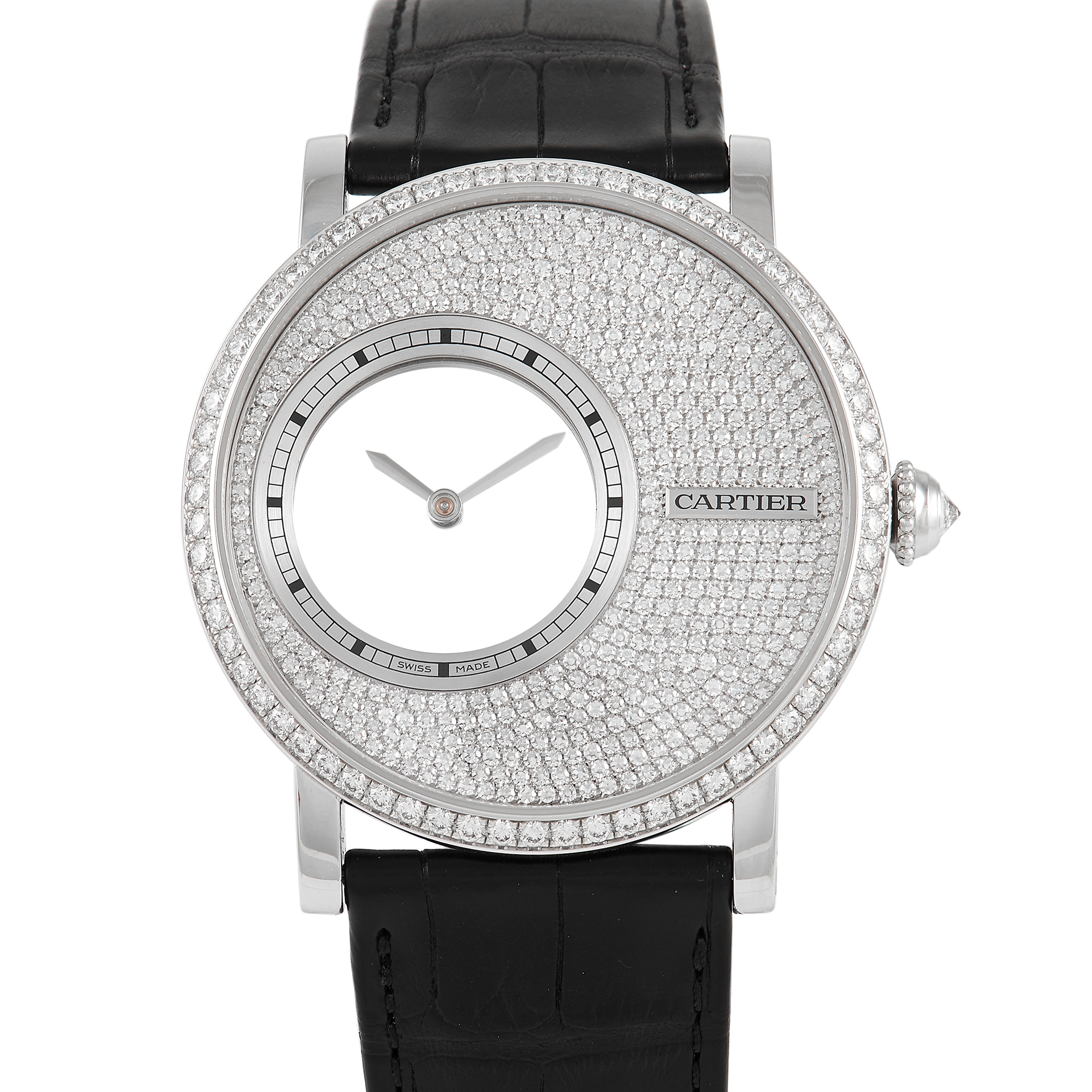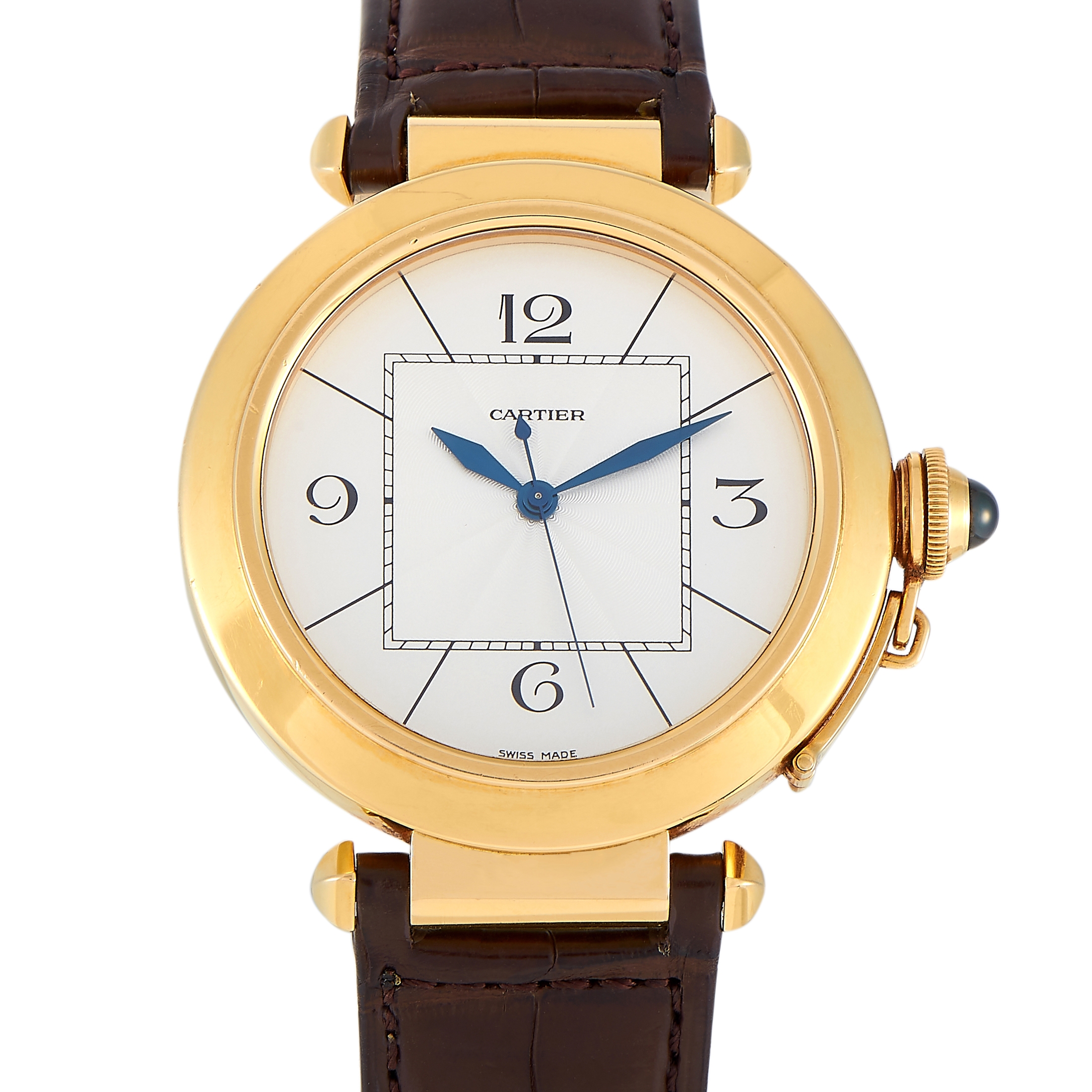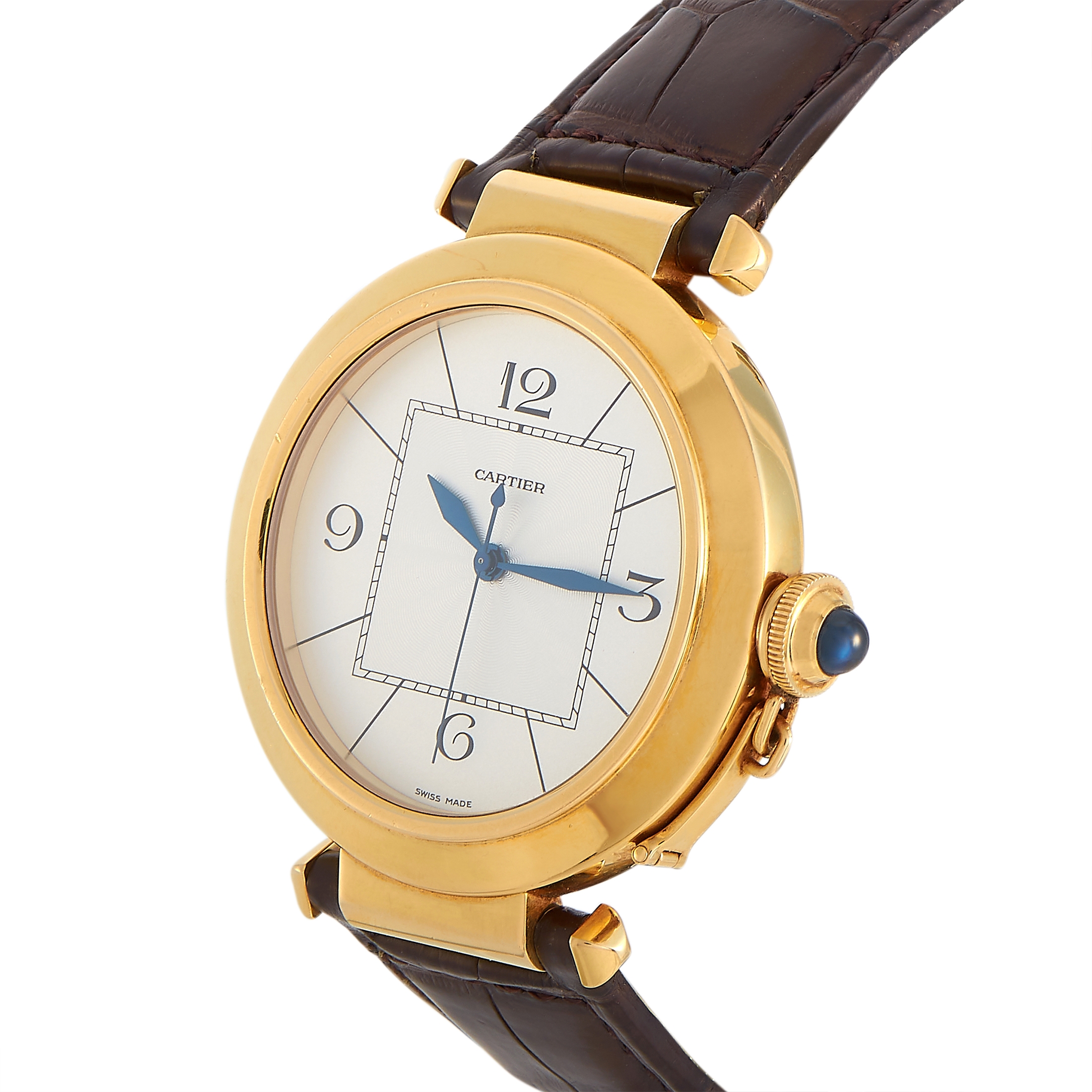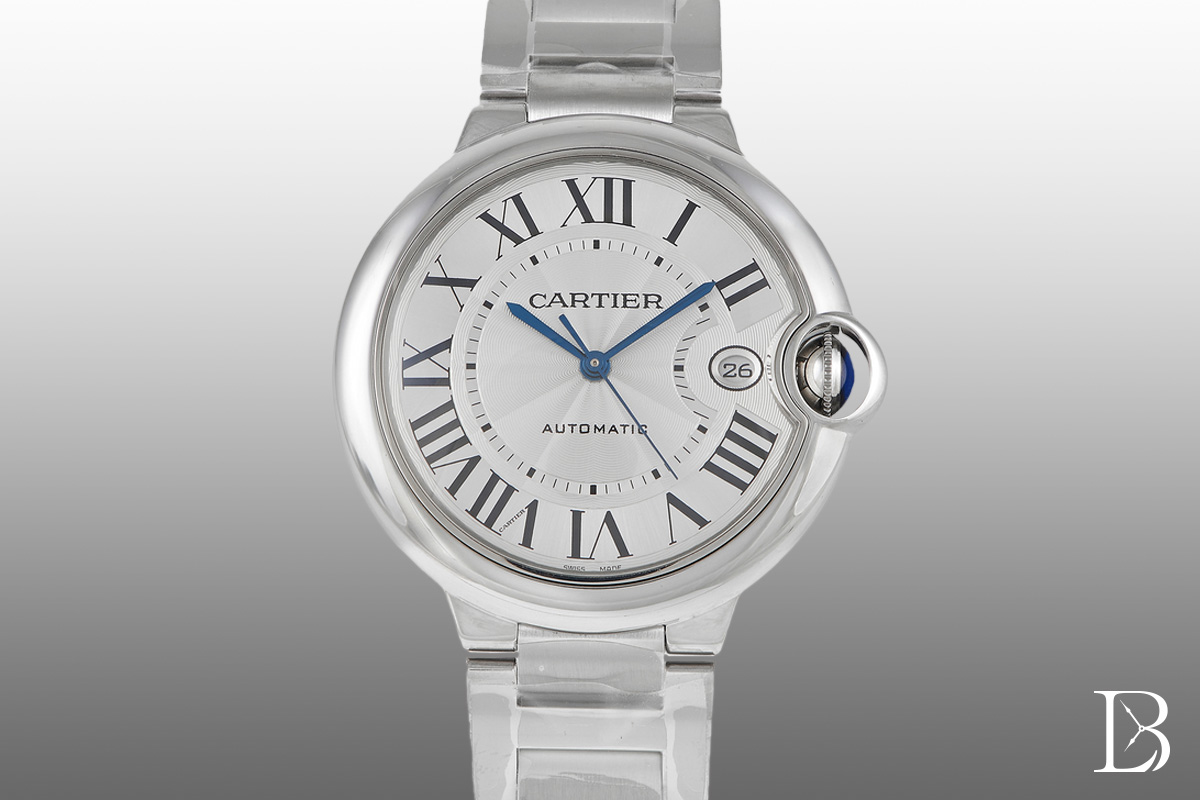Cartier has had a long history of making watches, and the brand is even credited with creating the first purpose-built men’s wristwatch back in the early 1900s when pocket watches were the norm for men. While the brand is French, modern Cartier watches are made in Switzerland.
Over the last century, Cartier has been responsible for plenty of iconic luxury watches, many of which have been part of the brand’s lineup for decades. Plus, thanks to their unisex watch designs and abundant size choices, Cartier has always catered to both men and women.
Cartier watches are known for their enduring and refined designs. Many of them have looked remarkably similar throughout the years, which makes Cartier a particularly great brand to buy pre-owned. In short, Cartier watches are classics and will never go out of style.
Jump to a section:
- Cartier History
- Cartier Watch Manufacturing
- Grey Market and Authorized Dealers
- Notable Models
- Notable Patrons and Owners of Cartier Watches
- Sponsorships and Collaborations
- Commonly Asked Questions About Cartier Watches
Cartier History
Early History
In 1847, Louis-François Cartier established the Cartier jewelry brand by taking over his master’s workshop during the tumultuous period of the French Revolution. As the Second Empire emerged, the business flourished, culminating in the launch of the first Cartier boutique in 1859. Alfred Cartier, Louis-François’ son, assumed control of the business and relocated it to the prestigious rue de la Paix in Paris’s jewelry district. Alfred’s sons, Pierre and Jacques, later expanded the Cartier brand to London and New York.
Meanwhile, Alfred’s third son, Louis, remained in Paris to oversee Cartier’s domestic expansion. Louis Cartier introduced innovative ideas, such as the use of platinum in jewelry. King Edward VII named Cartier “Jeweler of Kings, King of Jewelers”.
Alberto Santos-Dumont is considered one of the fathers of aviation and even flew around the Eiffel Tower in his airship No. 6 in 1901. Louis Cartier and Alberto Santos-Dumont were good friends and the aviator asked the jeweler to create a timepiece he could wear while flying since operating a pocket watch was too cumbersome. So Louis Cartier obliged and in 1904 designed what would later become known as the Santos watch – a small square wristwatch with a precious metal case, tiny screws on the square bezel, and a leather strap. The Cartier Santos watch, which was eventually made available to the public in 1911, was the first men’s (purposely-built) wristwatch and the first pilot’s watch ever made. While Cartier’s first foray into watches came in 1888, these timepieces were made exclusively for ladies.
The Santos-Dumont watch paved the way for Cartier to focus on wristwatches, including men’s wristwatches, which were still a novelty at the turn of the 20th century. In 1907, Cartier signed a contract with Edmond Jaeger (of Jaeger-LeCoultre fame), who agreed to supply movements for Cartier watches.
Timeline of notable Cartier Watch Models:
- 1904: Santos
- 1906: Cartier Tonneau
- 1912: Cartier Baignoire and Cartier Tortue watches, Mystery Clock Model A
- 1917: Cartier Tank
- 1928: Tortue Monopusher
- 1967: Crash
- 1977: Must de Cartier
- 1983: Cartier Panthere
- 1985: Cartier Pasha
- 1998: Collection Privée Cartier Paris (CPCP)
- 2002: Cartier Roadster
- 2007: Cartier Ballon Bleu
- 2010: Cartier Calibre
- 2015: Cartier Clé
- 2016: Cartier Drive
The 1970s was a tumultuous decade for the Swiss watch industry thanks to the arrival of quartz movements, which were not only more accurate but cheaper too. To keep up with the times, Cartier launched the less expensive Must de Cartier watch series in 1977 (including the Must de Cartier Tank), which featured vermeil cases instead of precious metal ones and largely had quartz movements instead of mechanical ones. The Must de Cartier watches were a huge success and allowed the brand to be accessible to a wider audience.
Recent Developments
In 2008, Cartier announced its Fine Watchmaking Collection to showcase high-horology pieces such as tourbillons, minute repeaters, perpetual calendars, grand complications, and plenty of iterations of its signature mystery movements.
In 2010, Cartier debuted the Calibre de Cartier collection as part of its standard catalog with in-house-made automatic movements at the heart of all the watches. A few years later, a Cartier in-house chronograph movement joined the lineup.
The shift towards in-house movements signaled to the world that Cartier was ready to take the mechanical aspect of its watches as seriously as its prized designs.
Cartier Watch Manufacturing
Notable Inventions and Designs
Cartier is often credited with inventing the first purpose-built men’s wristwatch (rather than repurposing a pocket watch to wear on the wrist) in 1904.
While the vast majority of watch brands focus on traditional round watches, Cartier is known for its mastery of shaped watches. From square to rectangular, barrel to oval, asymmetric to elongated, Cartier’s non-round watches are about as famous as the brand that makes them. This isn’t to say that Cartier does not offer round watches (it does); however, some of Cartier’s most famous timepieces have corners or unexpected curves.
Regardless of the shape of the case, most Cartier watches feature a handful of characteristic design touches. These signature Cartier details include:
- Black Roman numerals for hour markers
- Blue sword-shaped hands
- A rail-track style minute scale
- Guilloché decoration on a dial
- A secret Cartier signature embedded in one of the numerals
- A blue stone set into the winding crown
One particular area of horology that Cartier is famous for advancing is mystery clocks and watches. Mystery dials feature hands that seemingly float on a transparent dial, without the help of any obvious mechanical components. Louis Cartier was inspired to make these mystery clocks in the early 20th Century with help from watchmaker, illusionist, and magician, Jean-Eugène Robert-Houdin.
Production
According to a Morgan Stanley Swiss Watch Industry report published in 2022, Cartier secured the second spot as the largest Swiss watch brand (in turnover) in 2021–only surpassed by Rolex and taking over from Omega.
In the report, the analysts estimate that Cartier sold 600,000 watches over the year. Cartier belongs to the Richemont Group, which is home to other top luxury watch brands like Vacheron Constantin, Jaeger-LeCoultre, IWC, Panerai, A. Lange & Söhne, and others.
In 1972, Cartier transferred its watch production from France to La Chaux-de-Fonds, Switzerland. Fast-forward about three decades, and the company opened the state-of-the-art Cartier Watchmaking Manufactures in 2000. Today, Cartier’s watchmaking facilities include five separate sites across Switzerland.
Cartier does a lot of its production in-house, from design to manufacturing. The brand operates a site called Maison des Métiers d’Art, dedicated to crafts such as marquetry, enameling, gem-setting, and fine watchmaking.
Grey Market and Authorized Dealers
Boutiques and Authorized Dealers
According to Bloomberg, Cartier operates 270 stores worldwide, including flagship stores in Paris, London, and New York. The brand is specifically looking to expand in the U.S., and along with opening new stores, Cartier is also taking over some storefronts from authorized dealers, and sells goods online in select markets.
Only the current collection is sold at Cartier boutiques and authorized dealers, priced according to the master manufacturer’s suggested retail price (MSRP) list. Retail prices for Cartier watches range from $2,500 to $300,000; however, popular men’s Cartier watches generally fall within the $5,000 to $12,000 range while popular women’s Cartier watches can start as low as $2,500.
Grey Market Prices
Generally speaking, regular production Cartier watches do not hold their value as well as some other luxury watch brands such as Rolex, Patek, and AP. As a result, you can often find discounted Cartier watches for sale in the grey market.
There are, of course, a few exceptions, including some highly popular modern models (particularly from the Santos and Tank collection) that can sell for a premium on the secondary market. Furthermore, rare Cartier watches from the ultra-exclusive Collection Privée Cartier Paris (CPCP) line are highly collectible, therefore, command high prices in the market.
Another exceedingly collectible Cartier watch is the rare Cartier Crash, which has become one of the brand’s most sought-after in recent years thanks to it being worn by celebrities like Jay-Z, Kanye West, Kim Kardashian, and Tyler, the Creator.
Notable Models
Cartier is not one to shy away from experimenting with watch designs. As such, the company has made dozens of different timepiece designs over the last century — some of which have been discontinued while others have continued to be mainstays of Cartier’s catalog. Below is a list of Cartier’s most popular watches.
Tank
The Tank is not only Cartier’s most famous watch model, but it is also one of the most beloved watch designs of all time. Taking its name and design inspiration from the military armored vehicles that roamed the battlefields during World War I, the Cartier Tank was created in 1917.
The watch featured a rectangular case with vertical sides (referred to as “brancards” by Cartier) that stretched out far enough to serve as lugs to hold the leather straps in place.
Cartier debuted the Tank timepiece to the public in 1919 and since then, the company has made various iterations of the watch. Particularly notable ones include:
- Tank Louis Cartier
- Tank Française
- Tank Anglaise
- Tank Américaine
- Tank MC
- Tank Cintrée
- Tank Solo
- Tank Must
Regardless of the version, all Cartier Tank watches retain their distinctive brancards.
Santos
At the turn of the 20th century, aviator Alberto Santos-Dumont needed a watch he could read while flying one of his pioneering machines. Since keeping both hands was required to steer the aircraft, a traditional pocket watch was not practical. Santos-Dumont told his friend, Louis Cartier, about his dilemma, and Cartier answered the call by designing a watch in 1904 that the pilot could wear on his wrist.
This watch became known as the Cartier Santos and it is not only credited as the world’s first pilot watch but also the world’s first purpose-built wristwatch for men. Cartier Santos watches generally have square cases, rounded edges, and visible screws on the bezel and bracelet. Similar to the brand’s other watch models,
Cartier has made several versions of the Santos over the decades. Some of these include:
- Santos de Cartier
- Santos-Dumont
- Santos Chronograph
- Santos Galbée
- Santos 100
- Santos Demoiselle
Panthere
Introduced in the 1980s, the Cartier Panthère quickly rose as a must-have status symbol of the decade. The Panthère watch is similar to the Santos watch in that it has a square case with rounded corners, in addition to a bezel with visible screws. However, what sets the Panthère apart from other Cartier watches is its distinctive bracelet with brick-like links.
Although Cartier discontinued the Panthère watch collection for a short time, thankfully the Maison brought it back in the mid-2010s for a new generation to fall in love with. Today, Cartier offers the Panthère in several bracelet variations, from a classic single wrap to a double wrap to a bold cuff style — but always with the supple links that are as slinky as the big cat the watch is named after.
Ballon Bleu
The Ballon Bleu is one of Cartier’s more modern watch models, released in 2007. Designed to look like a pebble, the Ballon Bleu (French for blue balloon) is named after the blue stone-topped winding crown that looks like it is floating inside the case’s integrated crown cap.
Unlike traditional round watches that are flatter in profile, the Cartier Ballon Bleu is voluminous thanks to its domed sapphire crystal and convex caseback. In addition to the classic time-only Ballon Bleu, Cartier has also made other versions like the Ballon Bleu with a date window, Ballon Bleu Chronograph, Ballon Bleu Extra-Flat, Ballon Bleu Tourbillon, and Ballon Bleu Moon Phase. Cartier has also recently released the ultra-luxurious Ballon Blanc (white balloon) jewelry watches with an off-center diamond-set crown cover.
Pasha
Conceived by famed watch designer, Gerald Genta, and launched in 1985, the Cartier Pasha was a sports watch unlike any other during its time. The watch emphasized the unusual combination of a square inside a circle by combining a round case and dial with a square minute track at the center. Other defining details included fancy Vendôme lugs and a cap covering the winding crown that’s attached to the case via a chain.
According to Cartier lore, the Pasha name originates from a custom water-resistant watch that was made for the Pasha of Marrakesh, Thami El Glaoui, in the 1930s. Cartier removed the Pasha watch from its lineup for a few years, only to bring it back again in 2020. While current Pasha models are clearly based on the same design language as the original versions made in the eighties, nineties, and early-2000, Cartier has updated the watches with some notable improvements including interchangeable straps, a sapphire crystal caseback, a new crown, and a dedicated area for personalized engraving.
Whether looking at new or vintage models, there are plenty of versions of the Pasha including time-only, time and date, chronographs, tourbillions, GMTs, and divers.
Drive
In 2016, Cartier unveiled an entirely new men’s watch collection called the Drive. As its name suggests, the Cartier Drive is a vintage automotive-inspired wristwatch, where the guilloché on the dial is reminiscent of retro radiator grills while the crown draws its design cues from bolts used on cars. The wide but thin cushion-shaped cases of the Drive watches are unmistakable vintage, tastefully paired with classic leather straps.
A touch sporty but entirely elegant, the Drive is available in a few versions including time and date, extra-thin, moon phase, dual time, and tourbillon. Irrespective of the complication of the watch, the Drive watches run on in-house Cartier movements.
Ronde
Named after the French word for round, Ronde watches are not the typical shaped watches that Cartier is famous for making. Yet, these round watches are instantly recognizable as Cartier creations thanks to signature brand designs like the Roman numerals and blue hands on the dials, not to mention the blue stone-topped crowns.
However, Cartier Ronde watches do have a few distinguishing features too. First, there are the double chapter rings on the dials, where the outside one has Roman numerals (from 1 to 12) while the inner one features Arabic numerals (from 13 to 24.) This layout not only permits the wearer to read the time on a 24-hour scale but also adds visual interest to the face of the watch.
Whether the simpler Ronde Solo in steel, the luxurious Ronde Louis Cartier in precious metals, or the sporty Ronde Croisière with ADLC black-coating, the Ronde lineup is Cartier’s approach to the traditional wristwatch silhouette.
Rotonde
Introduced in the mid-2000s as part of Cartier’s exclusive “Collection Privée Cartier Paris” line, the Rotonde de Cartier collection often served to highlight the brand’s complex watchmaking skills.
Along with high-horology pieces such as Rotonde tourbillons, perpetual calendar chronographs, and minute repeaters, Cartier also made some more simplified and accessible Rotonde watches too including chronographs, calendars, and dual times.
Inspired by the shape of rotundas, Cartier Rotonde watches have round cases, straight lugs, and leather straps. They also have beaded-edge winding crowns set with blue cabochon-cut stones and mechanical movements inside the cases.
Crash
A product of “Swinging Sixties” London, the amorphous Crash watch is a cult favorite among Cartier enthusiasts. While the origins of the avant-garde case shape of the Crash was once said to be the result of a melted Cartier oval watch that barely survived a car accident, that story is merely a myth. It was the outcome of watch designers trying to make an oval Cartier watch look like it had been in a fiery car wreck.
Vintage Cartier Crash watches were produced in exceedingly low numbers, which makes them a rare find in the secondary market. Cartier has released a few new Crash models in more modern times, but always in limited production runs. In short, Crash watches are one of the most, if not the most, collectible Cartier watches ever made.
Clé
Released in the mid-2010s, the Clé is yet another innovative case design by Cartier, which features a novel key-inspired winding crown mechanism reminiscent of the turning keys that were necessary to wind antique clocks.
The ovoid-shaped Clé case is home to a round dial and round bezel. In addition to the new watch design, the Clé de Cartier is noted for debuting Cartier’s then-new in-house automatic movement. While the earliest batches of Cartier Clé watches were exclusively fashioned in gold, the company soon expanded the collection with two-tone and steel variants as well. What’s more, in addition to standard time and date models, Cartier frequently uses the Clé collection to demonstrate its watchmaking mastery with complications such as mystery hours, tourbillons, and skeletonized movements.
Tortue
Designed in 1912 and named after the French word for turtle thanks to its tortoise-shell-shaped case, the Tortue watch is classic Cartier. In fact, this was the third wristwatch design to come out of Maison Cartier. Cartier has never manufactured Tortue watches in large numbers but instead, produces them with serious Cartier connoisseurs and collectors in mind.
As a result, Cartier only crafts Tortue watches from precious metals such as varying shades of gold or platinum. Women’s Tortue watches are often set with diamonds too. Along with the classic Tortue watches with time-only dials, Cartier has also made Tortue watches with complications such as monopusher chronographs, perpetual calendars, and multiple time zones.
Calibre
The Calibre de Cartier was the line that debuted Cartier’s in-house-made automatic movement in 2010. Bold in design, Cartier Calibre watches feature 42mm cases, fat lugs, and prominent bezels. Dials are home to expanded date windows, thick Roman numerals, and luminescent sword-shaped hands.
While Cartier no longer makes the Calibre de Cartier, the collection was varied with choices ranging from time-and-date to chronographs to divers.
Roadster
The Roadster is yet another discontinued Cartier watch collection that remains popular in the secondary market. Borrowing design cues from open two-seat sports cars of the 1950s and 1960s, Cartier Roadster watches feature details such as windshield-inspired magnification lenses, crowns made to look like tires, and some dials that mimic auto dashboards.
Cartier made several variations of the Roadster watch during its production run, including time and date, chronograph, and GMT models.
Notable Patrons and Owners of Cartier Watches
King Edward VII of England famously referred to Cartier as “The jeweler of kings and the king of jewelers.” From royalty to modern-day celebrities, Cartier has always been a favorite brand among elite circles.
Cartier watches have graced the wrists of some of modern history’s most famous people. Some of the highlights include:
Athletes
- Muhammad Ali
- Stephen Curry
- Devin Booker
- Joe Burrow
- Cristiano Ronaldo
Celebrities
- Rami Malek
- Jeremy Piven
- Tom Hiddleston
- Jeff Goldblum
- Jay-Z
- Andy Warhol
- Rihanna
- Kim Kardashian
- Mila Kunis
- Sofia Vergara
- Jacqueline Kennedy Onassis
Royalty
- Diana, Princess of Wales
- Catherine, Princess of Wales (aka Kate Middleton)
- Meghan, Duchess of Sussex (aka Meghan Markle)
In 2017, Kim Kardashian purchased former First Lady Jackie Kennedy’s gold Cartier Tank watch at auction for $380,000. Andy Warhol once said about his Cartier Tank watch: “I don’t wear a Tank to tell the time. In fact, I never wind it. I wear a Tank because it’s the watch to wear.”
Sponsorships and Collaborations
Similar to many luxury watch brands, Cartier has a roster of celebrity brand ambassadors to its name. Some of the newer famous names that Cartier watches count as brand ambassadors include Rami Malek, Willow Smith, Troye Sivan, Maisie Williams, Jackson Wang, and Austin Butler.
Cartier is also committed to supporting arts, music, and film as illustrated by the company’s sponsorship of the Venice Film Festival, the Fondation Cartier for contemporary art, and the Cartier Metanoïa music project.
Commonly Asked Questions About Cartier Watches
Are Cartier Watches Worth It?
Most Cartier watches range in price from $2,500 to $12,000 and are worth every penny. Thanks to their iconic designs and renowned quality, Cartier watches are some of the most popular luxury watches in the market.
Do Cartier Watches Hold Value?
Some Cartier watches hold their value while others, less so. For instance, the value of quartz Cartier watches will typically depreciate much faster than mechanical ones. If you purchase a brand new Cartier at retail, expect depreciation. Purchasing Cartier watches from a grey market dealer or pre-owned dealer can help offset some of that initial value loss. However, there are some highly collectible Cartier timepieces, such as Crash watches and select Privée watches, that command high premiums in the collector market.
How Much is a Cartier Watch?
Retail prices for Cartier watches range from $2,500 to $300,000; however, popular men’s Cartier watches generally fall within the $5,000 to $12,000 range while popular women’s Cartier watches can start as low as $2,500. Pre-owned Cartier watches are often discounted, anywhere from 10% to 25% off their original sticker prices.
Is Cartier Considered a Luxury Watch?
Cartier makes some of the most iconic luxury watches in the market including the popular Tank, Santos, Panthere, and Pasha models.












